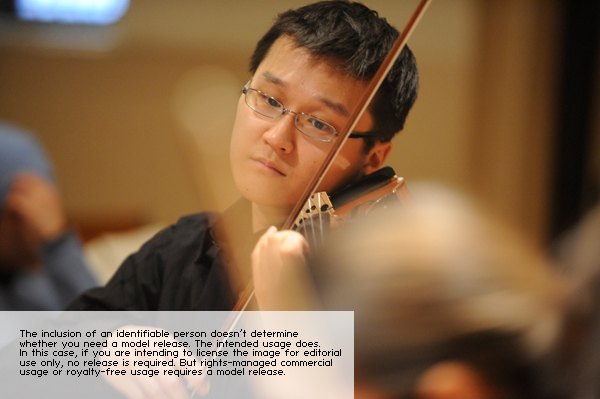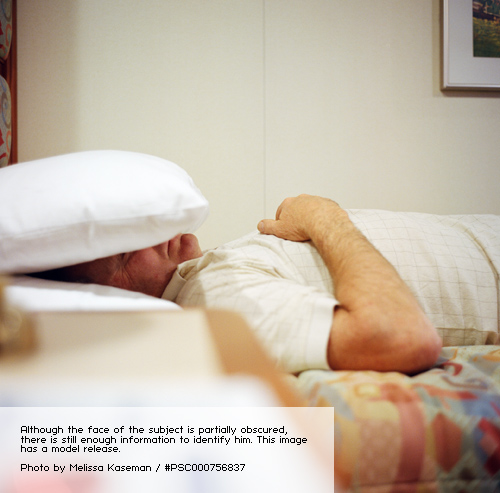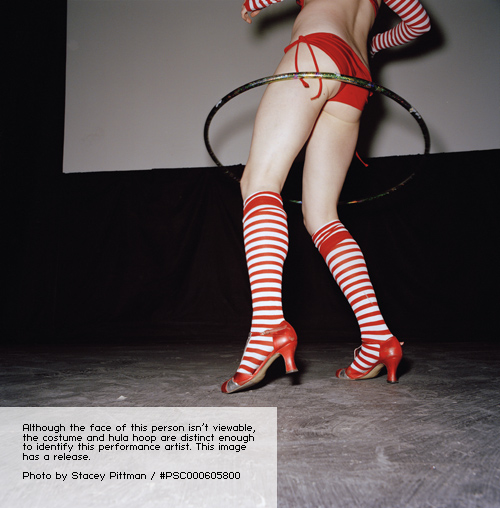Share
Model Releases and Stock Photography
Model releases aren’t just for professional models! Any person appearing in your stock photos is considered a model, and to maximize the profit p...
Model releases aren’t just for professional models! Any person appearing in your stock photos is considered a model, and to maximize the profit potential of an image, you should obtain a model release, which gives you consent to license the image for commercial purposes.

What is the point of a model release?
Model releases are required primarily to protect two of the subject’s rights: the right to publicity and the right to privacy. The right to publicity ensures that everyone has the right to control how and when their likeness is used. When a model signs a release they are allowing the photographer to profit from the sale of their likeness.
The right to privacy gives everyone the right to live a private life. Although a person in a public venue is fair game to photograph, people can reasonably expect not to be photographed in private areas against their will. Similarly, a model release therefore asserts that the photographer had permission to take a particular picture, and that the subject has consented to their likeness being sold as stock. In addition, models can request that the picture not be used in certain contexts (such as to promote cigarettes or prescription drugs) through the model release.
Model releases can make or break a sale
There have been a number of legal cases where models have successfully sued buyers and photographers over images taken or sold without their permission.
One such case is the story of the Simon family. A posed portrait of the family intended only as a private keepsake ended up on a Royalty Free stock photography CD-Rom published by PhotoDisc, Inc. It was then purchased an unknown number of times, and used in widespread ad campaigns by companies and organizations such as Rogaine, Macy’s, and the Christian Coalition.
The Simons sued in part because they had not consented to the sale of their likenesses as stock, and were personally offended by some of the causes the portrait had been used to support. More than a dozen buyers of the image were named in the lawsuit. In November 1998, PhotoDisc awarded the Simon family a $1.5 million settlement.
Buyers naturally don’t want to open themselves up to this risk, and most are very careful to use only model-released images for advertising or other commercial usages.
I asked Bethany Rouslin, a senior photo editor at Time Inc. Content Solutions, if she searches specifically for photos that have a model release. “Always,” she said. “Here at Time Inc. Content Solutions, we produce promotional collateral including magazines, magalogs and websites for single clients. Due to the advertorial nature of most of our publications, we only look for model and property released images with very few exceptions.”
Kilsy Curiel, a freelance art buyer, agrees. “For commercial use, we do look for a release for legal reasons. For editorial use…it’s not necessary.”
I also asked both buyers what they would do if they found an image that was absolutely perfect for their needs, but did not have a model release. Rouslin replied, “Occasionally a stock image is perfect for a story but isn’t released. Depending on the uniqueness of the image and the degree of need, we will sometimes put in a request for the photographer’s contact info so that we can try to get our own consents. If a release cannot be obtained, the decision to go ahead with using it then goes to our lawyer. In most of these cases, we end up having to find a replacement image, and as one can imagine, these efforts can be very time consuming and frustrating.”
Curiel’s response was similar- “with no model release, we will skip it and not show it to a client even if the image is what we were looking for.” She then added, “With a model release, the image will be more marketable.”
So while there is a legal justification for model releases, the more significant reason from a photographer’s perspective is that a release increases the earning potential of a stock image.
When is a model release needed?
You need a model release for each identifiable person in your photo if you intend to license the image for commercial usage.
Even if the subject of your photo is someone you know, and you could get a release at any time, it’s in your best interest to obtain one and upload it now. Buyers are busy, and will not necessarily have the time or inclination to track down a photographer to find out whether or not they can get a release.

If you don’t have a model release, your image can still be sold, but for editorial use only- to illustrate a factual story such as in a magazine, newspaper, or textbook. It can never be used commercially (i.e. for advertising or any other use that seems to endorse a product or point of view), UNLESS-
a) The buyer intends to manipulate the image so that the people are no longer recognizable (blurring out faces, for example).
b) The buyer is willing to assume a HUGE amount of risk.
Don’t count on either of these two things happening. If possible, always get a release.
What does it mean for a person to be identifiable?
The litmus test for determining if a person is “identifiable” is generally if they can be recognized by someone who knows them, such as a friend or family member.
The subject does not need to be famous in order to be considered identifiable. The subject does not have to live in a developed, westernized country to be considered identifiable.
If you can see the subject’s face, they are definitely recognizable. Even if the face is partially covered, it is very often still possible to identify the person.


Even if the person’s face is fully obscured or they have their back turned, they might still be identifiable because of the context.

Models can also sometimes be recognized because they have unusual characteristics, such as tattoos, birthmarks, or very unusual clothing.

Although it is usually impossible to obtain a model release for each person in a crowd, crowd scenes often include many identifiable people.

If there is any doubt as to whether your subjects are identifiable or not, choose “don’t have release” rather than “no identifiable person in picture.” “No identifiable person in picture” should only be chosen in the following cases:
a) There is no person in the picture at all.
b) The person or people in the picture are so far away, indistinct, or generic they cannot be identified, even by a person who knows them well.


Model Releases and Nudity
Because of the serious issues surrounding child pornography, model releases are absolutely essential for any image that contains nudity, even when the subject would not be considered identifiable. “Nudity” in this case is exposure of private parts of the body, (buttocks, breasts, genitals), whether the context is sexual or not. If these body parts are mostly obscured, the model is not considered nude.
a) If the model shows clear signs of advanced age, a model release is still necessary, but the date of birth might not be.
b) Images of very young nude children (toddler and younger), with model releases signed by their guardians might be acceptable.
c) Images of nude children in contexts where child nudity is culturally appropriate might sometimes be approved for editorial usage.
What do model releases have to do with pricing?
The pricing scheme you choose determines how your image can be used.
Royalty-free (RF) is the least restrictive pricing scheme. When you price an image RF, you grant the licensee the right to use it in virtually any context in perpetuity. The pricing is only restricted by the size of the image purchased. For this reason, all RF images containing people must include a model release. This requirement is enforced industry wide from the microstock sites to the largest stock companies.
On the other hand, rights-managed (RM) pricing allows much greater control over how exactly images are used and for how long. Images with recognizable people that do not have a release must be priced RM and restricted to editorial usage only. This ensures that they are not used for advertising or anything else that suggests the subject endorses a particular product or holds a particular world view.
Note that the News+ collection and editorial-only usage are not the same thing. An image can fall firmly within the contemporary or pro creative collections, and still be used to illustrate a factual magazine article or textbook chapter. The Creative vs News+ category distinction describes the aesthetic qualities and newsworthiness of an image; it does not determine how the image may be used.
In most cases it is the photographer’s choice if they would like to sell their model released images as RF. However, the stakes are higher when it comes to celebrities- they are more concerned with maintaining a certain public image, and generally more careful about managing exactly how their likeness is used. For this reason, portraits of famous people should not be priced RF even if you have a model release. Even if you are best friends with a top actress and she agreed to pose for a shoot with you and signed a release, you should price the photos as editorial only. Otherwise, there is nothing to prevent some pharmaceutical company from snapping up one of those portraits for their latest embarrassingly graphic ad campaign- likely not a usage she would approve of.
Veracity and Model Releases
Claiming you have a release when you don’t, even if you think it’s easily obtainable, are grounds for termination of your PhotoShelter account. A model release is legal documentation of consent, and therefore, we take issues surrounding releases seriously. If you do not possess a model release and have not uploaded it to PhotoShelter, do not claim that you have one.
Obtaining a Model Release Template
You can use our generic model releases if you do not have one:
1. Model Release for Adults
2. Model Release for Minors (requires a parent/guardian to co-sign). In the U.S., a person under the age of 18 cannot enter a legal contract, therefore, you must obtain the co-signature for the document to be valid.
Please note that you will need to be logged into the photographer’s area of the site in order to access these linked documents.
What happens if I really can’t get a release?
If you really don’t have and cannot get a model release, you must price your image as rights managed- editorial only.
This does not mean that a buyer cannot ever use it for a non-editorial purpose, but they will be prompted to negotiate with our sales team beforehand.
Remember, model releases open up the number of opportunities for the potential sale of your stock images. So commit yourself to getting those releases signed whenever you’re shooting stock!


